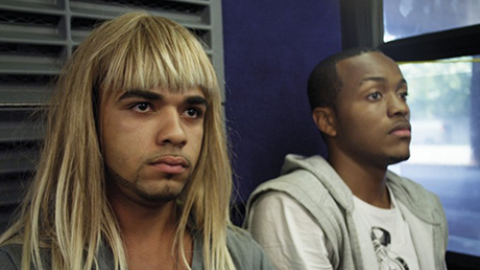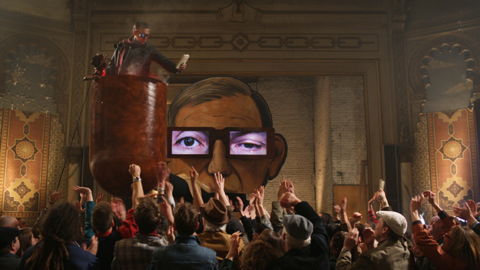Interview: Michel Gondry
Aside from his oneiric flights of fancy powered by eye-popping special effects—which always have a sense of the handmade, even when assisted by CGI—Michel Gondry is perhaps most closely associated with crafting love stories. His latest film, the as-yet-undistributed Microbe & Gasoline, contains negligible amounts of either. Instead, it tells an unaffected tale of pre-teen friendship between the artistic Daniel (Ange Dargent) and the self-assured, mechanical-whiz Théo (Théophile Baquet). Both boys are outsiders—Daniel’s too shrimpy to date, hence “Microbe,” and Théo smells like a garage and enjoys mouthing off—and come from homes that are unhappy in their own way. Daniel’s mother (Audrey Tatou) suffers from bouts of depression that strain her marriage, while Théo’s parents struggle with poor finances and his mother’s heart condition. Forging a bond stronger than anything they have at home, they build a car from scratch to escape to Theo’s old summer camp (where large-bosomed girls are supposedly bountiful). However, because their car is ineligible for a license because it’s too small (and obviously illegal), they decide build a house on top to throw off any police.
Their cross-country adventures in the house-car showcase Gondry’s best comic instincts, and beautifully illustrate how true companionship in those awkward years feels. In the spirit of this tactile road movie, the following interview was conducted en route to an Upper West Side record store, where Gondry almost immediately wanted to leave: “I have so much stuff, it depresses me. I need to move, I have too much stuff.” Microbe & Gasoline had its U.S. premiere in the 2015 New York Film Festival.
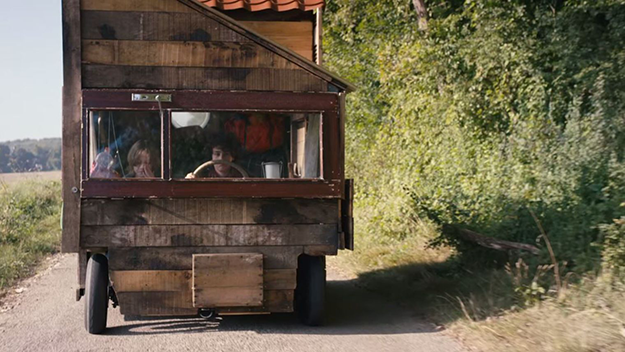
Microbe & Gasoline is somewhat of a departure from the past couple of films that you’ve done. Can you talk about what motivated you to do something a bit more personal, instead of something more elaborate with a big budget?
I think especially after Mood Indigo, which was an adaptation of a very iconic French book, I wanted to do something really coming from me, something personal. So I turned back to myself and some memories. As I started to collect them, I focused on the friendship that I had developed in my teenage years.
How did you get back to that place? Were there books that you revisited or music that you listened to? Did you go through old notebooks or diaries?
No, I didn’t have to. I mean, everybody has tons of memories, and if they connect to each other, and they serve the story, then I keep them. Some I write down and then I cross them [out] because they’re outside the main story.
Such as?
It’s hard to explain. You write them down and then you write little [index] cards and sometimes they just don’t fit into the continuity. I really wanted to keep the ones that explained why the two individuals, the two teenagers, become friends with each other.
Friendship is really hard to get right in film. Romantic relationships are shown all over the place, but a frank depiction of friendship, which I think this is, is sort of rare. How did you achieve that?
I think it’s a lot about the casting. But even in the writing—I remember what my issues were at this age, which still probably are the same, and how I would exchange frustrations with my friend about what his issues were, how he would respond to my problems. I just put that on paper.
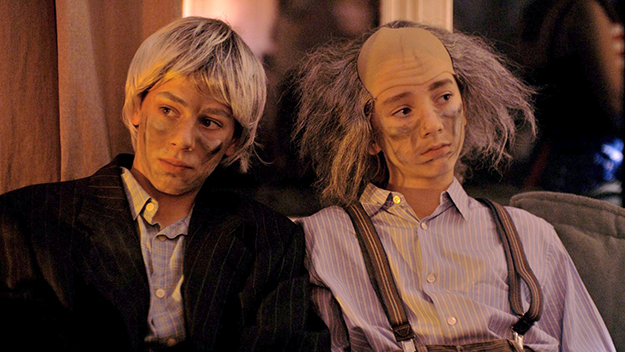
Was there a lot of improvisation? Because—there are a lot of dogs walking in front of us right now—there’s a saying: you shouldn’t work with children or animals. But you got excellent performances out of your young actors. Is the approach different?
Yeah, I didn’t treat them like dogs, if that’s what you’re implying. [Laughs] No, we didn’t improvise much, actually. When we rehearsed, we changed some lines, some words that they felt were too outdated or they would never say.
They’re obsessed with the old as opposed to the new. They say that “we’re still in the paper age.”
Yeah, because they like to make stuff with their hands. That’s why they bond as well. Daniel likes to paint and draw, Théo likes to construct stuff, to work with mechanical things. So they aren’t into video games and iPhones and all this technology too much. That was not really a statement I was trying to make. It was more that I was trying to adapt the type of activities we were doing at this time to kids living now.
Were you a hobbyist as well at that age, or were you more into art?
More into art but not like museums and stuff. I liked to draw and build stuff as well, like planes or cars or whatever.
This is your second film with Audrey Tatou. Her character is a lot more complex than the usual ingénue roles she’s often had. Did you write the role of Daniel’s mother for her?
After Mood Indigo, she suggested that instead of going to do Ubik—another big adaptation—I should do something more personal. She was very supportive of the project, and she accepted the role of the mother, which is a very small part. She just embodied, very accurately, my mother at this age when she was very nice but she had depression, so she was not very reassuring.
It’s a very realistic portrayal of depression, which again in many films is usually an abstraction or a device to get from one point to another. Is it based on your memories at that time?
It was based on my memories. I remember clearly the day that my father asked us—my brother and me—to comfort her and I simply refused because I felt that I didn’t have to be subjected to that at my age. Maybe I was wrong, but that’s how I felt.
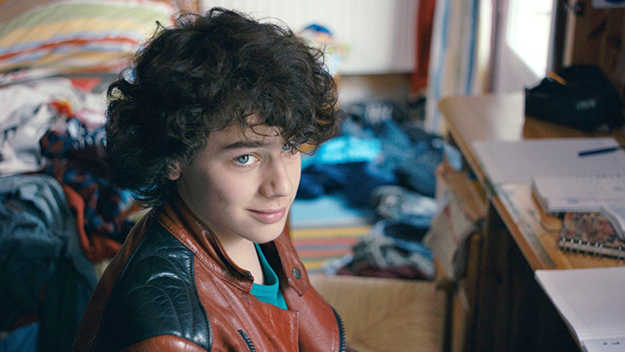
Music isn’t a huge part of this film because Daniel is sort of set up in opposition to his older brother who has a punk band. Was that also something from your personal experience?
At the time I did the portrait [that Daniel draws in the film], my friend Renoir and I were more into punk and new wave, and my brother was into heavy metal. So I shifted everything, because now punk isn’t very avant-garde. Daniel and Théo are against music in general, against pop music, and stuff like that.
When you’re approaching writing a film, are there any books or images that you return to help guide the process of structuring it?
No, I listen to some music to help me write and focus, but it’s hard to translate it into book because even if you start from the book, it’s such a different way of writing. You have so many pages and chapters that you have to put it in slices. So, no, I don’t start from books.
[We drop into the bookstore and walk by some records.]
If you were here without the intrusion of an interviewer, what do you think you would drift towards?
Michael Jackson. I mean, my taste goes from Bach to Olivier Messiaen to John Cage. Early electronic music. My grandfather invented the synthesizer in the late Forties.
What was it called?
It was the Clavioline. It was even used by The Beatles. I’m so proud of that. It didn’t make my family very rich—I didn’t come from a super rich family at all. My father played a lot of Duke Ellington, and he loved the sound of the Hammond organ. I love jazz music too but Duke Ellington was one of the first to use the old synthesizers from the Thirties before my grandfather. So I love this music.
I’m sure I inherited some of my grandfather’s inventiveness. My mother was creative—she was a musician. So I have some genes going into this direction and… I wanted to talk about something else concerning music but I forgot.
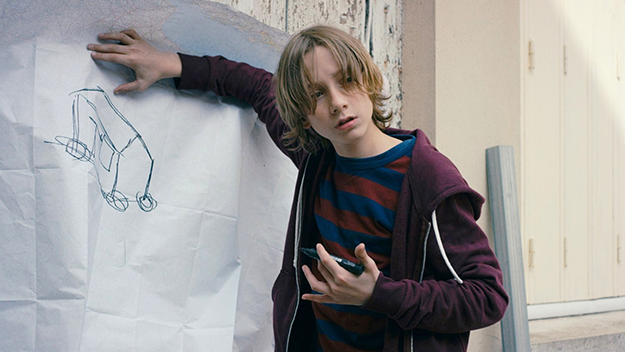
We can move around the store. I don’t know if it will help.
I’ll tell you something, I have so much stuff at home that I can’t buy anything anymore. So the goal is not to buy anything.
Going back to Microbe & Gasoline, the film has some interesting symmetry to it, visually and in terms of the story and where it begins.
Symmetry?
Like at the beginning, when Daniel looks at the back of Laura’s head, and then at the end, she looks at the back of his head, and you can hear her thoughts, that she wants him to turn around. I feel like there are several moments like that. Was that something you envisioned immediately, or did that evolve during the writing?
I think this idea came quite early—the irony that first Daniel’s in love with Laura and then she’s in love with him. It fulfills Théo’s prophecy that Laura’s going to be in love the day he doesn’t care any more for her. The symmetrical part is them going away and then having to come back.
I love when they’re on the plane, and the flight is completely backwards, confusing, and anxiety-ridden for both of them.
Well, Daniel questions the reality of what happened to them. In fact, in the first draft of the screenplay, I wrote it much more about these dreams and about questioning everything. But then I said to myself: “OK, I’ve done too many dreams in my movies, I should avoid it.” I mean, there’s already this sequence when they see Laura coming out of the water [in reverse motion]. It’s dreamy too but I tried to avoid it…
Is there anything besides dreams that you’re trying to avoid at this point of your career?
No… I really wanted to shoot just a straightforward story.
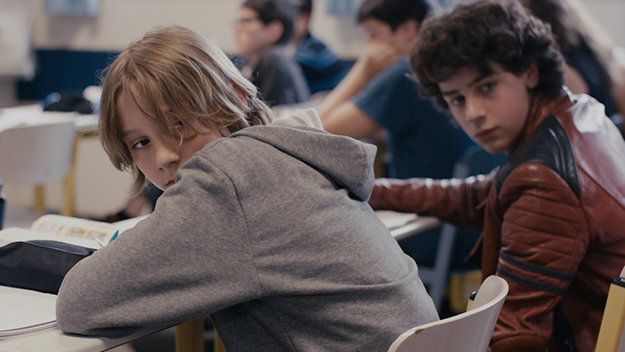
I really loved Microbe & Gasoline, but I also enjoyed Mood Indigo, and I was surprised how resistant people were to it. Do you have a sense of why? You did release a director’s cut.
I don’t know if I prefer the director’s cut or not. It’s hard to talk about that because I don’t want to dismiss a film that I like so much. One of the reasons was maybe that it’s from a novel that everybody has read, so everybody has their own idea. It’s very visual even in the writing, so I put my own vision on it and many people didn’t agree with it.
I tried to read a new translation of the book, and a lot of things had very obviously been changed and updated. Boris Vian is so visual, as you say. He plays with language in a way that Serge Gainsbourg’s lyrics do. It’s hard to translate something like that to another language or visually.
It’s funny you mentioned Serge Gainsbourg. My composer composed music for Serge Gainsbourg—he composed the whole album Melody Nelson. One day I had this dream about Charlotte Gainsbourg, because we’re friends and we’ve worked together [on The Science of Sleep]. When I woke up, I thought of her mother, Jane Birkin, who had this song, “Di Doo Dah,” which had this nostalgic and moving rhythm that I thought would be perfect for the film. I realized that Jean-Claude Vannier, who did Melody Nelson and many other scores, composed it. I contacted him from this dream right away to do the music. So there is a connection with Serge Gainsbourg. Serge Gainsbourg was a friend and sort of a pupil of Boris Vian.
Are you a big fan of Gainsbourg?
Yeah!
It’s hard not to be, if you’re exposed to it. It’s rich and appealing, and then you see so many people who sort of borrow from it. That whole Beck album The Information…
Yeah, and the sixth album was very much inspired by Melody Nelson, and Melody Nelson was composed and arranged by Jean-Claude Vannier, who was Gainsbourg’s favorite, from what I heard, but I’m not sure of the details.
How involved are you in the editing process of your films?
Very closely. This one was very straightforward. I worked Elise Fievet, an editor who I had never worked with before, and I liked it because she wasn’t trying to do anything fancy. You have to make these sorts of decisions because it’s always too long. I listened a lot to my editor, and I proposed things and we generally agree if it’s better or not. Generally I have a good relationship with my editor. Sometimes it’s more intense, like in Eternal Sunshine. It was super intense—we had a physical fight.
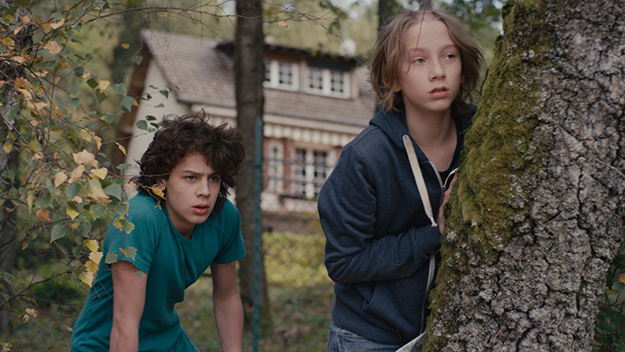
Over what?
She [Valdis Oskarsdottir] didn’t want to try some ideas I had, but she was great. It’s funny because she brought a lot to the film and the producer always wanted to fire her because she was so obnoxious. She’s Icelandic.
This morning I re-watched My New New York Diary which you did with Julie Doucet. At some point you were doing more stuff with comics, and now you’re not.
Yeah, it’s funny because my girlfriend [at the time] was doing comic books and I thought of this sort of fusion. Sometimes I was a musician, and my girlfriend was musician, so we did more music. I’m sort of a sponge. I had done comic books before I met her, and My New New York Diary was actually a story, an idea, I wanted to do with my girlfriend and then she decided she didn’t want to participate any more. So I asked Julie Doucet if she wanted to do it, and she said yes right away.
That project was interesting because it was sort of like a transitional phase between Be Kind Rewind and the art world. I remember you had a show at Deitch Projects that was an extension of Be Kind Rewind, where people could swede whatever they wanted. Then The We and the I took you back to more overtly fictional, film projects.
Yeah, it was a time when I’d go in many directions, maybe too many directions. It’s how it was.
You won’t do anything more with comics in the foreseeable future?
I don’t know.
Or gallery shows?
No, I did my 1,600 portraits from my website and I’m a little bit burned out.
Who did the drawings for this film?
Me. It was a fun thing to do.



